Swamp People returned sans my favorite swamp people. I took if off the DVD recorder list and the show was subsequently canceled. Magic remote? Possibly. I intend to remove Street Outlaws – New Orleans this evening to see if I get the same result. My wife and I watched the Oklahoma version religiously, but I cannot understand a word that comes out of Kye Kelley’s mouth or his chuckle head associates. I am sure many feel the same about my writing. I was unclear, incomplete and generally impudent in providing subject firearm foundation, so I decided to flesh it out a bit.
A tribute to Bisley, not a copy…
Great Britain’s National Rifle Association was founded in 1859. Its purpose was to provide marksmanship training to a corps of volunteers assembled to defend against a potential French invasion. The first official annual marksmanship competition was held at Wimbledon Common in July 1860. By 1890, the competition had been moved to the National Shooting Centre at Bisley. In 1894, Colt produced a Bisley Model of the Colt Single Action that included adjustable sights and a grip frame contour and was intended for competitive shooting and as a tribute to the British event 1) 2).
In the early 1980’s, in the midst of a good deal of customer demand, Ruger’s Larry Larson designed his interpretation of a Bisley revolver, with Bill Ruger determining the final grip frame profile. The Bisley went into production as a Ruger New Model Blackhawk variation in 1985 3). The Ruger Bisley remains quite a departure from the Colt Bisley and from the Elmer Keith No.5 grip profile.
The Ruger cylinder frame angles downward to the grip frame, and the grip frame transitions at the same angle. The Colt cylinder frame projects straight back to the grip frame and then curves downward with a tighter radius. The frame, barrel and cylinder of the Ruger are robust in comparison to the Colt which allows it to withstand heavy magnum loads with ease.
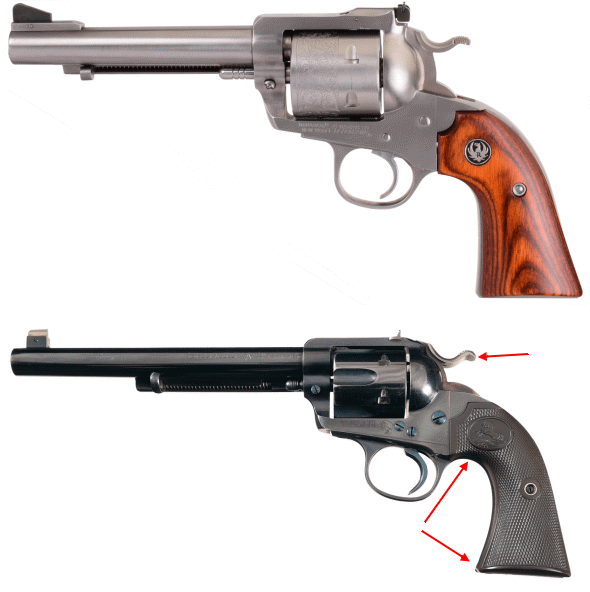
The Colt hammer is set in closer to the frame than the Ruger and approximately 0.100″ higher, which works with the Colt’s thinner humpbacked grip as the palm of the hand is placed closer to the frame and the thumb is closer to the hammer. The Ruger backstrap flares rearward, the Colt less, and the Colt front strap raises high behind the trigger guard to form deep inset curve.
The Ruger pictured below is a 41 Remington Magnum Bisley version of the Blackhawk. The configuration was produced as a distributor exclusive, AcuSport, from June 2003 until 2007, with a final short run of 100 units produced in December 2015. While not currently in production, examples can be found at gun shows, dealers and online auctions.
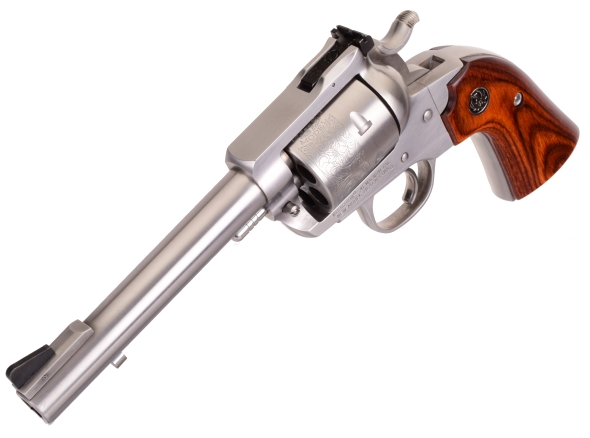
The cartridge…
The Ruger Bisley Blackhawk is a tank; heavy frame, large diameter cylinder, thick chamber walls, both outer and adjacent. The 41 Remington Magnum generates a good deal of power as depicted by traditional ballistic charts and its bullet carries a good deal of momentum, which generally means deep penetration.
| Indices | 210 Grain 137 Yards Point Blank Range | ||||
| Range | 0 | 50 | 100 | 150 | 200 |
| Velocity – fps | 1485 | 1324 | 1192 | 1091 | 1017 |
| Energy – ft.-lbs. | 1028 | 817 | 662 | 555 | 482 |
| Momentum – lbs-sec | 1.38 | 1.23 | 1.11 | 1.01 | 0.95 |
| Path – in. | -1.5 | 2.6 | 1.7 | -5.2 | -19.5 |
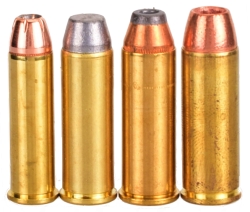 I don’t subscribe to the hard to get ammunition criticism as there are twenty five factory loads for the round, approximately three quarters of them in stock at any given time, enough to cover a broad array of applications.
I don’t subscribe to the hard to get ammunition criticism as there are twenty five factory loads for the round, approximately three quarters of them in stock at any given time, enough to cover a broad array of applications.
As a handloader, I am used to scrounging brass from many sources, making my own from other cartridge cases and casting my own bullets. That isn’t bragging, it is just a statement suggesting that if you love firearms and pursue many types, finding a way to keep firearms fed is an enjoyable part of the challenge.
The 41 Mag has a clear edge in performance over the 357 Mag. It is not far behind the 44 Mag and typically a good deal more potent than 45 Colt factory loads including modern high pressure factory ammunition. Pictured above, left to right: 357 Mag, 41 Mag, 44 Mag, 45 Colt. The 10mm auto is thought to be a cartridge with a good deal of thump, the 41 Mag holds 50% more powder and the 41 Mag handles much heaver bullet weights effectively.
It goes something like this…
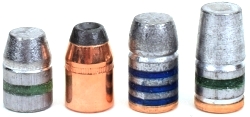
|
Manufacturer |
Bullet Type |
Bullet Weight Grains |
Overall Length “ |
Crimp Groove Depth “ |
| Hunters Supply | FP | 200 | 0.632 | 0.370 |
| Nosler | JHP | 210 | 0.688 | 0.370 |
| Cast Performance | WFNGC | 250 | 0.766 | 0.470 |
| True Shot | WFNGC | 265 | 0.845 | 0.410 |
Four bullets were selected for handloading in a useful range, 200 grains to 265 grains. A common weight, 170 grains, because going for velocity in a 5.5″ barrel revolver seems to fly in the face of bullet mass and penetration… unless impressing a chronograph is the objective.
The selection of powder is not based on a lack of imagination or accessibility. I started using H110 in place of Alliant 2400 with heavy Colt 45 loads and Ruger revolvers based on John Linebaugh’s seminal work on the cartridge and related firearms. I started heavy loads for the 41 Rem Mag with Blue Dot and stopped not because of problems arising, but because Alliant took a very strong position against use of the powder and persisted. I found H110 to work well in full charges and it did not pressure spike at the upper end.
I started using Lil’ Gun because it usually produced slightly higher velocity per grain with heavy charges and it provided more consistent velocity at the lower end. H110 tends to become erratic when loaded lightly. I added bulky Trail Boss to the data table because it makes for excellent and very uniform low velocity handloads for target practice and other recreational shooting. That said, put any of these behind a hard cast bullet and it will pass through a big hog or deer… or a hogadeer that populate the Jersey Pine Barrens.
Joe’s handloading tips
I find singing while handloading lifts the spirits, at least those of the singer, and sets a work cadence. I usually lead with Tennessee Ernie Ford’s Sixteen tons and work up to Aero Smith’s Walk This Way. My turret press production rate is 200 rounds at the onset and upwards of 6000 rounds per hour at the finish… if air guitar is omitted. For folks who like to work without human interruption, I find that midway through the exercise… Jonny Lang’s Lie to Me, I am left quite alone.
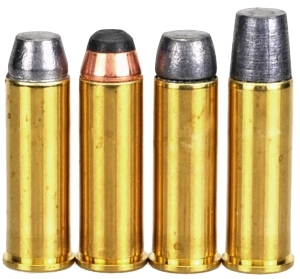
Left to Right – The Hunter’s Supply 200 grain hard cast has a Brinnel hardness of 15 in comparison to pure lead which has an approximate Brinnel hardness of 4. The Hunter’s Supply bullet is a antimony, tin and lead alloy that makes it non-expanding in soft tissue, but won’t shatter on bone. It is rated to 1,600 fps without a gas check and without bore fouling. Its applications are target practice, competitive shooting, small through large game.
The Nosler 210 is pure lead encapsulated in a tapered copper jacket. It fits the same applications as the cast bullet, but it offers controlled expansion and lesser penetrate. There is no lead fouling, but of course there is copper fouling which is easier to remove and takes much longer to accumulate.
The Cast Performance .41 caliber 250gr. WFNPB (wide flat nose plain base) is heavier and harder than the Hunter’s Supply bullet and falls somewhere between 18-21 Brinnel as a result of alloy blend and heat treating. The Cast Performance bullet is represented as up to 3,100 fps without leading. I don’t know as I have never shot them that fast, but I do they do not lead quickly. Good for big and dangerous game, but they also will not bounce off of deer or pigs.
True Shot is an Oregon Trail bullet brand. Another gas checked bullet, but with a long nose that extends assembled ammunition beyond the SAAMI COL spec of 1.590″ to 1.710″. They fit the Ruger’s long cylinder with approximately 0.040″ to spare. I do not know the Brinnel number for this bullet, but I do know that they are hard cast which puts them between 11 and 30. They are made from a proprietary mixture of alloys and precious metals, including silver, which suggests werewolves can be added to the list of applicable types of big game.
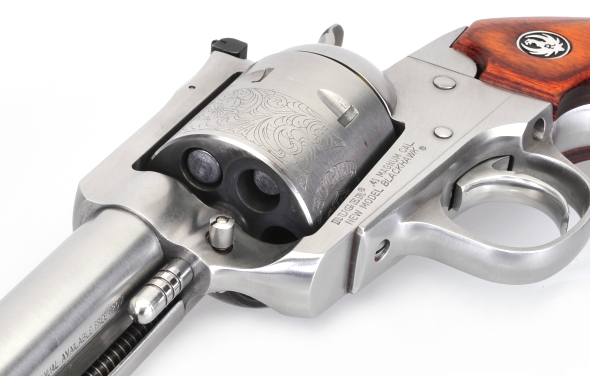
Seen above in the cylinder face, the long nose 265 grain bullet in comparison to the 200 grain cast bullet. A traditional roll crimp was enough to stop bullets from pulling even when left in the cylinder while other chambers were fired multiple times.
Factory and handload data
Factory ammunition, in regard to pressure and velocity, varies with manufacturer. Examples of factory ammunition variations? Sure. Notice the 265 grain approaching the high velocity 200 grain load and the 150 fps swing at 210 grains. All based on a 6″ to 6.5″ vented barrel –
| Ammunition | Bullet Grains |
Bullet Type |
Rated FPS |
| Grizzly | 210 | JHP | 1450 |
| Cor-Bon | 210 | JHP | 1350 |
| Grizzly | 250 | Cast | 1325 |
| Doubletap | 250 | Cast | 1370 |
| Cor-Bon | 250 | Cast | 1325 |
| Grizzly | 265 | Cast | 1400 |
| Buffalo Bore | 265 | Cast | 1350 |
There is not a great deal of mainstream handload data for the 41 Magnum, particularly for greater than 210 grain bullets, with the exception of the Lee Reloading Manual. However, the Lee manual offers little cartridge narrative and barrel length is omitted as it related to velocity performance.
Analyzing performance information from all handload data sources and factory ammo performance establishes some parameters or boundaries that help when developing handloads… i.e. if 265 grain loads are approaching 3,000 fps there may be a need to back off a tick or two. In any event, this is my handload manifesto :
 |
Warning: Bullet selections are specific, and loads are not valid with substitutions of different bullets of the same weight. Variations in bullet length will alter net case capacity, pressure and velocity. Primer selection is specific and primer types are not interchangeable. These are maximum loads in my firearms and may easily be excessive in others. All loads should be reduced by 5%, and developed following safe handloading practices as represented in established reloading manuals produced by component manufacturers. Presentation of these loads does not constitute a solicitation for their use, nor a recommendation.
|
||||||||||||||||||||||||||||||||||||||||||||||||||||||||||||||||||||||||||||||||||||||||||||||||||||||||||||||||||||||||||||||||||||||||||||||||||||||
|
|||||||||||||||||||||||||||||||||||||||||||||||||||||||||||||||||||||||||||||||||||||||||||||||||||||||||||||||||||||||||||||||||||||||||||||||||||||||
Shooting personality…. the gun, not mine
Whoever mouths the cliché, “The 41 Magnum’s recoil is between that of the 357 Magnum and the 44 Magnum” would probably also say, “West Virginia is between California and Virginia” as 41 Mag recoil is only little bit less than a 44 Mag with similar loads. The Trail Boss loads are really soft shooting and relatively quiet, very similar to the standard pressure 45 Colt. Full tilt loads… not so much. Subsequently, the Ruger was stuffed into the Ransom Rest, AKA Robo Joe, for accuracy testing.

No, this is not a primer for Hollywood gangster style shooting, it is a picture of the backside of the Ruger’s well formed Bisley grip, the same employed on the really big boy 454 Casull and 480 Ruger Bisley Super Blackhawks. There were no ill effects from extensive shooting and the grip angle, palm contact, trigger reach and control were excellent. Muzzle blast from low pressure loads was minimal for a big bore centerfire, but high pressure loads certainly announced their presence; big bark, which might be expected from a cartridge that produces twice the power of a 45 Auto +P load.
The Bisley is an excellent open carry revolver for both hunting and trail defense. While the Ruger Bisley New Model Blackhawk in 41 Mag may not currently be in production, it can be found in carefully used condition, like the subject revolver. There are five other models that are in current production, available in 44 Special, 44 Mag and 45 and one Hunter Bisley in 44 Mag.
Ruger’s Power House 41 Mag Bisley Blackhawk Part 1
Ruger’s Power House 41 Mag Bisley Blackhawk Part 11

Email Notification